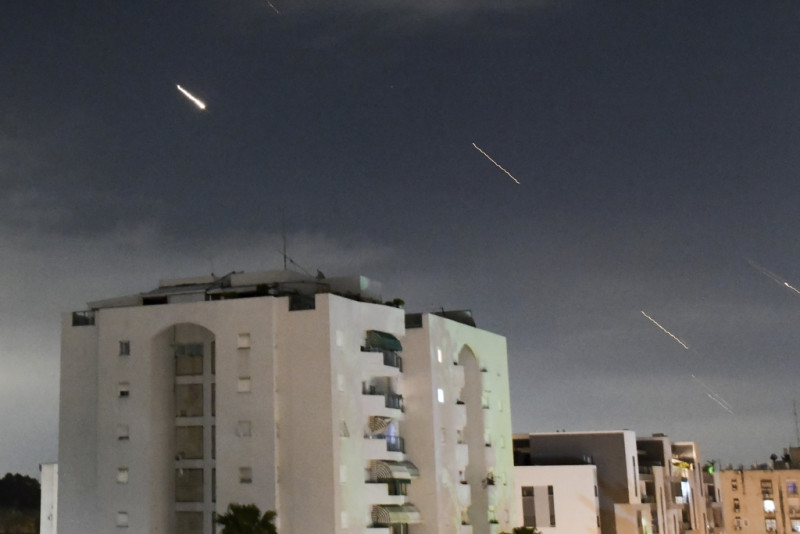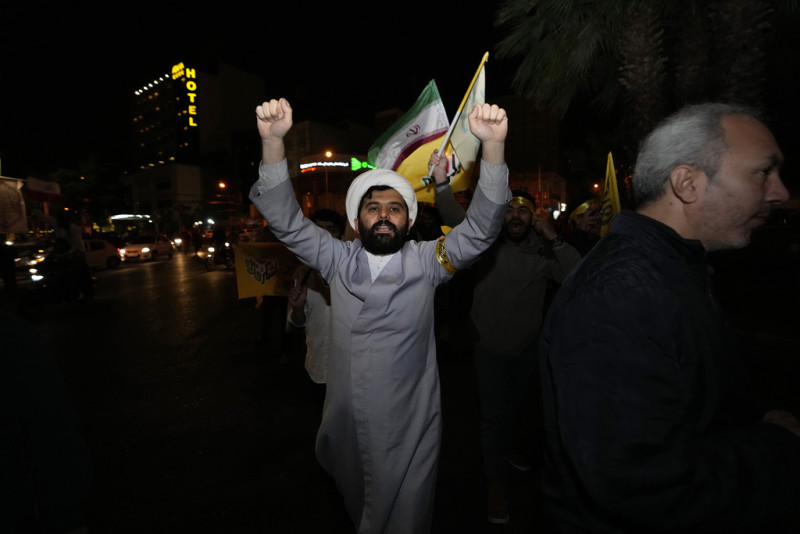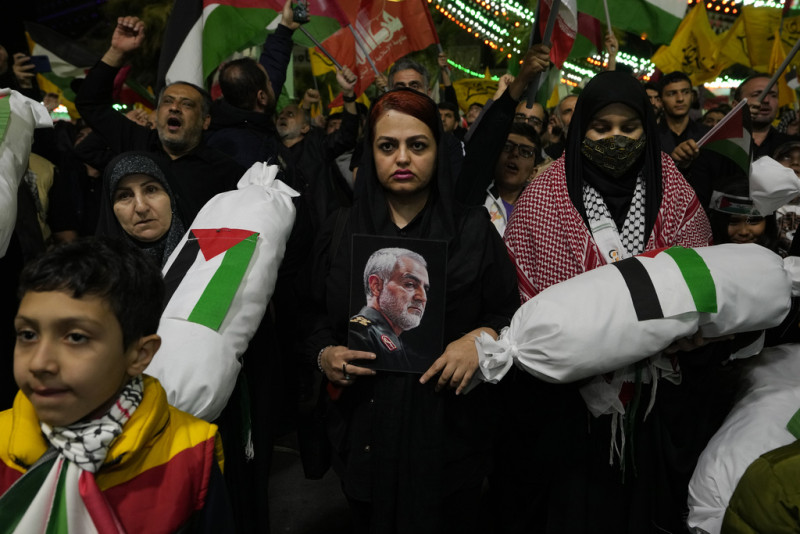The military confrontation between Iran and Israel has brought the entire world’s attention back to Iran’s armed forces
Iran launched more than three hundred remote-controlled drones and ballistic missiles against military targets in Israel overnight Saturday into Sunday, in retaliation for the Israeli bombing of its consulate in Damascus on April 1. “The showdown is not over,” says Israel.
🔴 Watch: Temple Mount/al-Aqsa Mosque tonight:
Israeli defense systems intercept Iranian missiles over Jerusalem. pic.twitter.com/nmhTdoXhUA
— David Saranga (@DavidSaranga) April 13, 2024
At the same time, Iran’s allies, notably Yemen’s Houthis and Lebanon’s Hezbollah, also launched attacks against Israel, with the former launching drones and the latter launching two drones against the occupied Golan Heights.
Why is Iran’s military important right now?
Israeli officials, as the “New York Times” writes, had declared that they would respond to any attack by Iran. All, almost, the international media write that this may provoke further retaliation from Iran and possibly expand into a wider regional war. There is even the possibility that such a conflict could involve the United States, although Washington has made clear that it had nothing to do with the attack on Damascus.
Analysts say Iran’s adversaries, notably the United States and Israel, have avoided direct military strikes against Iran for decades, not wanting to engage Tehran’s complex military apparatus. Instead, Israel and Iran have engaged in a long shadow war through air, sea, land and cyber attacks, while Israel has covertly targeted military and nuclear facilities inside Iran and killed commanders and scientists.
“There’s a reason Iran hasn’t been hit”stated Afshon Ostovar, associate professor of national security issues at the Naval Postgraduate School and an expert on the Iranian military. “It is not that Iran’s adversaries are afraid of Iran. It’s that they realize that any war against Iran is a very serious war.”
It is worth noting that the Israeli Prime Minister, Benjamin Netanyahu, whose army is waging a war against Hamas in the Gaza Strip – a Palestinian enclave that has suffered incalculable destruction since October 7 – spoke by phone with US President Biden after a meeting of the Ministry of War his council. However, Mr. Biden, according to international media, tried to discourage a possible Israeli counterattack on Iran, but Israeli Defense Minister Yoav Gallad said that the showdown with Iran is not yet over.
What kind of military threat does Iran pose?
Iran’s armed forces are among the largest in the Middle East, with at least 580,000 active personnel and approximately 200,000 trained reservistswho are split between the traditional army and the Islamic Revolutionary Guard Corps, according to an annual assessment by International Institute for Strategic Studies last year.
The army and the Revolutionary Guards each have separate and active ground, air and naval forces, and the Guards are responsible for the security of Iran’s borders. The General Staff of the Armed Forces is responsible for their coordination and determines the overall strategy.
The Guards also run the Quds Force, an elite unit responsible for equipping, training and supporting the network of paramilitary groups across the Middle East known as the “axis of resistance”. These militias include Hezbollah in Lebanon, the Houthis in Yemen, militia groups in Syria and Iraq, and Hamas and the Palestinian Islamic Jihad in Gaza. Iran’s armed forces are headed by Supreme Leader Ali Khamenei, who has the final say on all major decisions.
While the militias are not counted as part of Iran’s armed forces, analysts say they are considered an allied regional force – combat-ready, heavily armed and ideologically loyal – and could help Iran if attacked.
What kind of weapons does Iran have?
For decades, Iran’s military strategy has been predicated on deterrence, emphasizing the development of precision and long-range missiles, drones and air defenses. It has built a large fleet of high-speed boats and some small submarines that are capable of disrupting shipping traffic and global energy supplies that pass through the Persian Gulf and the Straits of Hormuz.
Iran has one of the largest arsenals of ballistic missiles and drones in the Middle East, Mr Ostovar said. This includes cruise missiles as well as ballistic missiles with a range of up to 2,000 kilometers or more than 1,200 miles.
In recent years, Tehran has amassed a large stockpile of drones with a range of about 1,200 to 1,550 miles and capable of flying low to avoid radar, according to experts and Iranian commanders who have given public interviews to state media. In fact, Iran proudly displays its trove of drones and missiles during military parades and aspires to build a large drone export business. Iran’s drones are used by Russia in Ukraine and have appeared in the conflict in Sudan.
Their bases and facilities are widely dispersed, buried deep underground and fortified with air defenses, making them difficult to destroy with airstrikes, experts say.
Where does Iran get its weapons?
International sanctions have cut off Iran from high-tech weapons and foreign-made military equipment, such as tanks and fighter jets.
During Iran’s eight-year war with Iraq in the 1980s, few countries were willing to sell arms to Iran. When Ayatollah Khamenei became Iran’s supreme leader in 1989, a year after the war ended, he tasked the Revolutionary Guards with developing a domestic arms industry and allocated resources to the effort, which was widely reported in the Iranian media. He wanted to ensure that Iran would never again have to rely on foreign powers for its defense needs.
Today, Iran manufactures a large amount of missiles and drones on its soil and has made this defense production a priority, experts said. His efforts to build armored vehicles and large naval vessels have met with mixed results. It is also importing small submarines from North Korea, while expanding and modernizing its domestically produced fleet.
How do other countries see the Iranian military and what are its weaknesses?
Iran’s military is considered one of the strongest in the region in terms of equipment, cohesion, experience, and quality of personnel, but falls far short of the strength and sophistication of the armed forces of the United States, Israel, and of some European countries, experts say.
Iran’s greatest weakness is its air force. Much of the country’s aircraft date back to the era of Shah Mohammad Reza Pahlavi, who ruled Iran from 1941 to 1979, and many have been decommissioned due to a lack of spare parts. The country also bought a small fleet from Russia in the 1990s, experts said.
Iran’s tanks and armored vehicles are old and the country has only a few large naval vessels, experts said. Two intelligence-gathering vessels, the Saviz and the Behshad, deployed in the Red Sea have helped the Houthis identify Israeli-owned ships for attack, US officials said.
Will Israel’s attack disrupt Iran’s military?
The killings of the senior military officials are expected to have a short-term impact on Iran’s regional operations, as commanders with years of experience and ties to the heads of allied militias were eliminated. However, the “chain of command” of the armed forces inside Iran remains intact, according to experts.
Iran has warned Israel of a major attack on its territory if the Israelis retaliate against Tehran’s overnight drone and missile attack on its territory.
Iran added that it has also warned Washington not to support any military action by Israel, otherwise it would result in Iran targeting US military bases.
Source :Skai
With a wealth of experience honed over 4+ years in journalism, I bring a seasoned voice to the world of news. Currently, I work as a freelance writer and editor, always seeking new opportunities to tell compelling stories in the field of world news.













